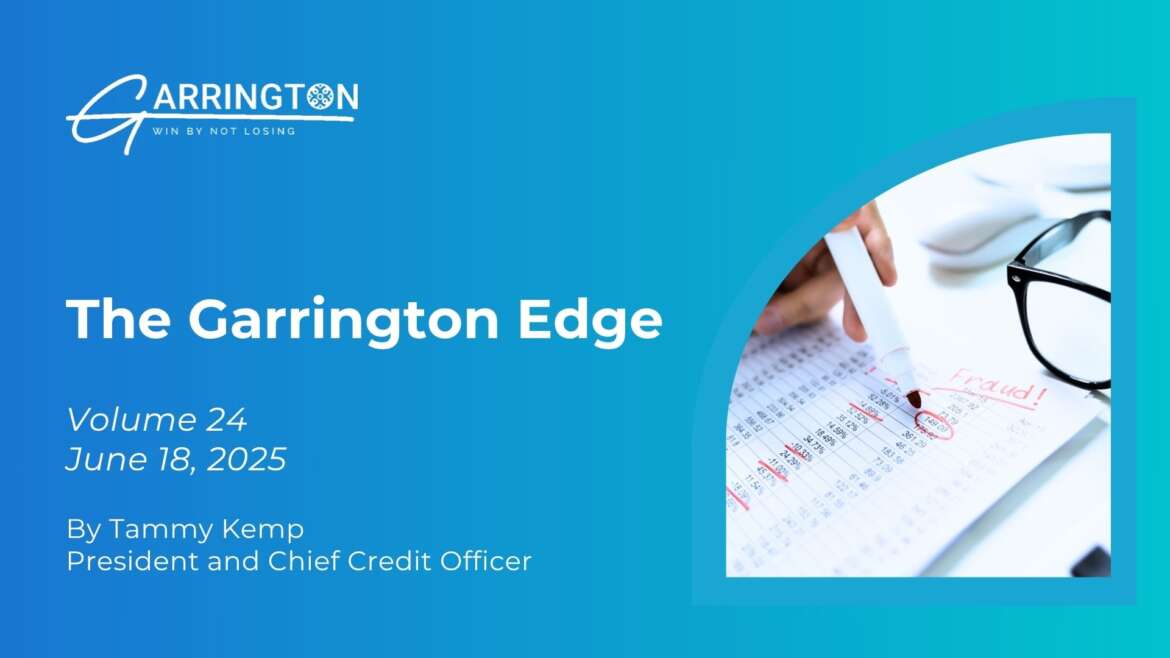When the Numbers Lie: A Real-World Reminder About Fraud and Safe Lending
In lending, fraud is the word no one wants to say out loud, but every credit professional thinks about. It’s the shadow in the room, the what-if that lives behind even the cleanest deal file. And while no lender can eliminate the risk of fraud, we believe you can reduce exposure through discipline, culture, and what we call safe lending.
At Garrington, safe lending doesn’t mean following a checklist. It means following your instincts. It means questioning the right things at the right time. Above all, it means building a lending environment where teams feel empowered to speak up, and where strong client relationships don’t prevent healthy skepticism.
Two Types of Fraud, One Common Thread
There are generally two kinds of fraud:
- The kind that emerges from desperation when someone makes a bad decision under pressure.
- And the type that’s engineered, where someone designs the system to deceive.
While the former can often be prevented through sound monitoring and open dialogue, the latter demands deeper vigilance, and a refusal to ever get too comfortable.
A Cautionary Tale Shared Across the Industry
The lending community shared a notable cautionary take that highlights the consequences of ignoring warning signs. The borrower was well-established, the deal was large, and the structure was standard: a revolving facility secured by accounts receivable and inventory.
At first, everything looked textbook. The CFO managed all communication. The field exam was clean. The company had hundreds of customers and consistently used their credit lines. But cracks began to show after a warehouse fire led to an insurance claim. An unusually low amount of inventory debris raised concerns, and investigations uncovered far more than fire damage.
A second field exam, conducted 18 months after closing, revealed overstated inventory, significant access restrictions, and unusually high unit costs on common items. A third-party review of receivables revealed a discrepancy between the reported accounts receivable (AR) and actual customer documentation. Invoices listed under major national retailers were often fabricated, some even recorded in internal systems at inflated values while only token amounts were sent to customers. Payments on those invoices were traced to unrelated third parties.
The scale of the issue was staggering. But the warning signs, in retrospect, were there all along.
Garrington’s Takeaways
At Garrington, we’ve spent years refining our approach to credit risk, and stories like this underscore what we’ve always believed:
- A single point of contact in a large organization should raise a flag, relationships should be built across multiple levels.
- Field examiners need variation. Using different teams or methods reduces the risk of complacency or collusion.
- Testing protocols should stay internal. Sharing test samples or processes with borrowers can create opportunities for manipulation.
- AR validation must go beyond portals. Confirmations, when possible, should involve conversations or independent third-party verification.
- Payment trail mismatches matter. If a major customer doesn’t pay their own invoices, something is off.
- Transparency from the borrower is critical. Resistance to access or information should never be ignored.
- Mix it up. Change how and what you test over time to avoid predictable patterns that can be gamed.
Why It Matters to Us
Stories like these aren’t meant to alarm, they’re meant to anchor us. At Garrington, we take fraud risk seriously, not because we expect it, but because we know that even one oversight can turn a great loan into a significant loss.
Fraud is the exception, not the rule. But vigilance is the rule, and it’s one we’re proud to follow.
Thanks for reading. In our next post, we’ll return to deal structure insights and walk through a few borrower success stories that remind us why this business is worth doing and doing well.




